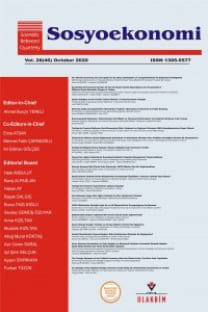Türkiye’deki hanehalklarının haberleşme talebinin ampirik analizi
Haberleşme, insanın yaşamını sürdürmesindeki temel ihtiyaçlardandır. Bu çalışmada haberleşme harcamalarının, bireylerin toplam harcamalarındaki payı, gelir ve fiyat esnekliklerinin düzeyi sorgulanarak, bu harcama türünün zorunlu mal mı, yoksa talebi esnek türde mallardan mı olduğu açıklanmaya çalışılmaktadır. Araştırmada Türkiye’deki haberleşme harcamaları verileri olarak 2002-2009 yıllarına ilişkin TÜİK hanehalkı bütçe anketlerinden yararlanılmıştır. Buradan hareketle Türkiye’deki 12 farklı harcama türünün hanehalklarının bütçelerindeki payı, gelir (harcama) ve fiyat esneklikleri, haberleşme harcamaları ile karşılaştırmalı şekilde analiz edilmiştir. Bunun için regresyon analizi ile değişkenler arasındaki ilişkinin anlamlılığı ölçümlenmiştir. Bunu takiben bütçe payının, fiyat ve gelir (harcama) esnekliklerinin analizi için Genişletilmiş Doğrusal Harcama Sistemi (ELES) uygulanmıştır. Çalışmada yapılan analizler sonucunda; Türkiye genelinde haberleşme harcamalarının bütçe payı yaklaşık %4, gelir (harcama) esnekliği 1’den küçük, fiyat esnekliği -1,06 olarak hesaplanmıştır. Bu nedenle haberleşme harcamaları, Türkiye örneği için, ihtiyaç malı olarak kabul edilebilir şeklinde yorumlanmıştır.
An empirical analysis of communication demand by households in Turkey
Communication is a basic need of human beings. For this reason, in this study, we want to obtain the communication expenditure is necessity or luxury good. So the ultimate goal is to assess the income (expenditure) elasticity and price elasticity of communication and it’s budget share, also comparatively estimate the elasticity of demand in different expenditures in Turkey. Thus these elasticities have to give a conceivable picture of changing consumption of communication by the households in Turkey. After all, the article presents empirical analysis of demand of communication and other kind of expenditures in Turkey, for the period 2002-2009. At the research, ELES method was utilized. According to the results of analysis; throughout the Turkey, communication expenditures budget share is nearly 4%, these expenditures income (expenditure) elasticity is less than 1, price elasticity is – 1.06%. Hence the demand of communication expenditure is acceptable as solid in the case of Turkey.
___
- Bağdadioğlu, N. & M. Çetinkaya (2008), “Türk Mobil Telekom Sektörünün Vergilendirilmesinde Vergi Yükü Analizi ve Olası Bir Vergi İndiriminin Etkileri”, Yaklaşım, 16, 28–32.
- Bin, X. & X. Renjing (2012), “An Emprical Analysis on the Consumption Structure of Town Residents, Jiangxi province-based on the extended linear expenditure”, International Conference on Applied Physics and Industrial Engineering, Physics Procedia, 24, 660- 66.
- Blanciforti, L. & R. Gren (1983), “An almost Ideal Demand System Incorporating Habits: An Analysis of Expenditures on Food and Aggregate Commodity Groups”, The Review of Economics and Statistics, 65, 511-15.
- Koutsoyiannis, A. (2004), Modern Macro Economic Models Assumptions, Çev. Muzaffer Sarımeşeli, Gazi Press, Ankara.
- Lluch, C. & R. Williams (1975), “Cross Country Demand and Savings Patterns: An Application of the Extended Linear Expenditure System”, Review of Economics & Statistics, 57, 320- 28.
- Lyssiotou, P. & P. Pashardes & T. Stengos et al. (2001), “Nesting Quadratic Logarithmic Demand Systems”, Economic Papers, University of Cyprus, 1-11, _____http://papers.econ.ucy.ac.cy/RePEc/papers/0201.pdf>, 23 April 2013.
- Narayana, N.S. & B.P. Vani (2000), “Earnings and Consumption by Indian Rural Laborers: Analysis with An Extended Linear Expenditure System”, Journal of Policy Modelling, 22, 256-65.
- Oğuz, F. (2013), “Universal Service in Turkey: Recent Developments and A Critical Assessment”, Telecommunication Policy, 37, 13–23.
- Özer, D.J. (1985), “Correlation and The Coefficient of Determination”, Psychological Bulletin, 97, 307-15, _____http://mres.gmu.edu/pmwiki/uploads/Main/Ozer1985.pdf>, 20 April 2013.
- OECD (2011), Communications Outlook 2011, _____http://dx.doi.org/10.1787/88932396390>, 17 April 2013.
- Rea, J.D. & G.M. Lage (1978), “Estimates of Demand Elasticities For International Telecommunications Services”, The Journal of Industrial Economics, 26, 363-81.
- Sasaki, K. & Y. Saegusa (1974), “Food Demand Matrix in An Approximate Linear Expenditure System”, American Journal of Agricultural Economics, 56, 263-70.
- Sarntisart, I. & P. Warr (2011), “Estimation of Consumer Demand System”, Crawford School of Public Policy Lecture Notes, 1-40, _____http://www.crawford.anu.edu.au/acde/prc/pdf/Paper_G1.pdf>, 25 April 2013.
- Shaukat, A. (1985), “Household Consumption and Savings Behavior in Pakistan: An Application of the Extended Linear Expenditure System”, The Pakistan Development Review, 24, 23-37.
- TÜİK (2011), Hanehalkı Bütçe Araştırması 2009, Publication Number: 3582, June, XXI-XXIII, Ankara.
- TÜİK (2012), Hanehalkı Bütçe Araştırması Tüketim Harcamaları Mikro Veri Setleri 2002-2009, Ankara.
- Ulman, P. (2011), “Equivalence Scale in Terms of Polish Households’ Source of Income”, Folia Economica Stetinensia, 10, 114-27, _____http://www.degruyter.com/dg/viewarticle.../contentUri?t:ac...2012>, 25 April 2013.
- Zhi-cheng, H. & L. Xiao-xiang & L. Zhi-xia et al. (2011), “Comparison Among The Consumption Structures of Different Income Groups of Urban Residents in Guanxi Based on Eles Model”, Asian Agricultural Research, 3, 34-36.
- ISSN: 1305-5577
- Yayın Aralığı: Yılda 4 Sayı
- Başlangıç: 2005
- Yayıncı: Sosyoekonomi Derneği
Sayıdaki Diğer Makaleler
Eğitim, Sağlık ve Teknoloji Düzeyinin Ekonomik Büyüme Üzerindeki Etkisi: ARDL Sınır Test Yaklaşımı
Work–Family Conflicts of Practitioners of Accountancy: Practice of Diyarbakir
Mustafa ZİNCİRKIRAN, Hidayet TİFTİK
Kamu Alacaklarının Korunma Yöntemleri ve Bir Değerlendirme
Patent Harcamaları ve İktisadi Büyüme Arasındaki İlişki: Türkiye Örneği
Kamu Üniversitelerinde Örgüt Kültürlerinin İncelenmesine Yönelik Bir Araştırma
Türkiye'de Vergi Denetim Sistemi ve Sistemin Aksaklıklarının Değerlendirilmesi
Türkiye İçin Politik İstikrarsızlık Endeksleri: 1955-2009 Dönemi
The Uncounted Who Wish to Work – Distinct to the Unemployed or Similar?
Türkiye’de vergi denetim sistemi ve sistemin aksaklıklarının değerlendirilmesi
